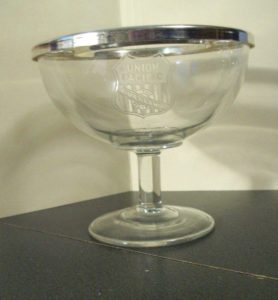Happy July and Happy Summer!
Here in Colorado, the temperature has been in the 80s and 90s, so it’s no time to turn on the oven. For this month’s posting, we are again going to a nice cool dish for hot summer evenings: shrimp cocktail.
Shrimp cocktail appears on dining car menus of the early 20th century, which makes sense as the technology of the refrigerated boxcar improved greatly between 1900 and 1940. Insulated boxcars date to the early days of railroading, approximately 1850, however they were most successful in cold weather because their insulation (sawdust, animal hair, and sometimes dirt) was not that efficient. Ice also was harvested from natural resources, and obviously, it was not readily attainable in most areas during the warmer months of the year. It wasn’t until the 20th century that refrigerated boxcars really became adequate for transporting perishable foods. As refrigerated boxcars, or “reefers”, became more efficient, there was an uptick in the service of perishable food on dining cars, such as the shrimp cocktail.

Figure 1 An early version of a refrigerated boxcar, circa 1870.
The simplicity of the shrimp cocktail (cold shrimp and cocktail sauce) does not seem to lend itself to an interesting history; however, there is actually an anecdotal story about the origin of this popular appetizer. Its origin is rather surprising, as it supposedly came to be via a miner in California in the mid-nineteenth century. The story goes that after a successful day of panning for gold in 1860, a miner treated himself to a whisky and a plate of oysters at a San Francisco bar. After swigging the whisky, he proceeded to dump the oysters into the cocktail glass, and then poured a mixture of vinegar, Worcestershire sauce, ketchup, and hot sauce over them. When asked by the bartender what he called his oyster mixture, he reportedly said, “I call this an oyster cocktail.” He then proceeded to drink the oyster mixture. Soon, bars across San Francisco were advertising oyster cocktails. The fact that the oyster cocktail was made in a cocktail glass, then imbibed rather than eaten, explains why we use the term cocktail for something food-related as opposed to beverage-related. As time went on, other kinds of seafood were served in cocktail glasses with a spicy tomato-based sauce, which eventually came to be known as cocktail sauce.
Shrimp cocktail would not become popular outside of coastal areas until the onset of traveling refrigeration, as shrimp are highly perishable. Once out of water, shrimp die quickly, and once dead, they decay quickly. The concept of flash-freezing fish upon catching it did not come into play until the 1920s. Therefore, it wasn’t until the early 20th century that the shrimp cocktail gained popularity. The early 20th century just so happens to be when we start seeing it on dining car menus.

Figure 2 Although it is hard to read, the top item on this 1918 Atchison, Topeka & Santa Fe menu is “Fresh Shrimp Cocktail”.

Figure 3 A Union Pacific shrimp cocktail dish. The metal rim is designed to hold shrimp over the cup filled with ice. Date unknown.
We also see shrimp cocktail serving dishes, and specialized flatware appear in dining cars at this time. Shrimp cocktail dishes tend to be stemmed glassware (as in Figure 3), or in some cases, like in Figure 4, metal dishes that held ice underneath with the shrimp on top. Within our collections at the Colorado Railroad Museum, we happen to have two small silver hors de oeuvres forks that are also known as shellfish forks. What makes these forks special is their three-prong design, with one prong sometimes a little heavier or longer on one side, to pull shellfish from a shell, or stab a shrimp in a cocktail glass.
However you choose to serve your shrimp cocktail, we hope you enjoy trying the recipes below. If you do try either of them, please share how they taste on our Facebook, Instagram, or Twitter accounts.
Shrimp for Cocktails, Milwaukee Road Style
Before you begin, you will need a 3-quart saucepan.
Preparation time is 1 ¼ hours.
Yield: One pound of shrimp.
Ingredients:
Tops from one bunch of celery
1 carrot, cut into 1-inch slices
1 small onion, quartered
½ teaspoon salt
1/8 teaspoon pepper
Pinch of paprika
1 bay leaf
1 pound raw shrimp
Add all ingredients, except the shrimp, to 2 quarts of cold water. Bring water to a boil, reduce heat, and slow boil for 1 hour. Place shrimp in mixture, cover tightly, and cook until shrimp are tender, exactly 6 minutes. Remove from heat immediately, drain and rinse in cold water. Pick shrimp out of the cooked vegetables, shell and devein, and keep refrigerated until ready to serve. Serve with cocktail sauce, if desired.
Seafood Cocktail Sauce, Atlantic Coast Line Railroad
For tastes that run to hair-raising, perspiration-inducing, breathtaking heat, this recipe won’t disappoint. Waiters quipped that they’d have to see how angry the chef was on a given day before they could describe how hot the cocktail sauce had gotten. To produce the desired degree of “heat,” adjust the amount of each ingredient accordingly.
Before you begin, you’ll need a small mixing bowl.
Preparation time: 1 ¼ hours (including minimum standing time)
Yield: 2 cups
Ingredients:
1 ½ cups tomato catsup
Juice of 1 lemon
2 tablespoons Worcestershire sauce
½ cup horseradish
Generous dash of Tabasco sauce
Salt to taste.
Combine all ingredients and mix thoroughly. Refrigerate at least 1 hour before serving; overnight if possible.
Recipes from Dining by Rail: The History and the Recipes of America’s Golden Age of Railroad Cuisine by James D. Porterfield, 1993.
In 2021 the Museum is operating socially distanced train rides each Saturday! Follow us on Pinterest, Facebook, YouTube, Instagram and Twitter.
Past Dining on the Rails Posts:
Dining on the Rails: June – How about a salad?
Dining on the Rails – Atchison, Topeka & Santa Fe Ham!
Dining on the Rails: CRI&P’s New England Boiled Dinner
Dining on the Rails: A Sweet Treat for your Valentine!
Dining on the Rails: Black Eyed Peas!
Dining on the Rails: Eggnog
Dining on the Rails: Happy Thanksgiving!
Dining on the Rails: Union Pacific Apple Pie
Dining on the Rails, August 2020
Dining on the Rails, July 2020
Dining on the Rails, June 14, 2020
Dining on the Rails, June 7, 2020
Dining on the Rails, May 31, 2020
Dining on the Rails, May 24, 2020
Dining on the Rails, May 17, 2020
Dining on the Rails, May 10, 2020
Dining on the Rails, May 3, 2020
Dining on the Rails, April 26, 2020
Dining on the Rails, April 19, 2020
Dining on the Rails, April 12, 2020






